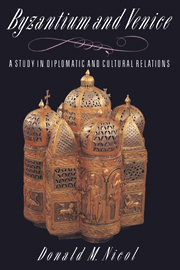Book contents
- Frontmatter
- Contents
- Dedication
- Preface
- List of abbreviations
- Maps of the Byzantine and Venetian worlds
- 1 Venice: the Byzantine province
- 2 Venice: the Byzantine protectorate
- 3 Venice: the ally of Byzantium
- 4 Venice: the partner of Byzantium
- 5 Byzantium, Venice and the First Crusade
- 6 The parting of the ways
- 7 The calm before the storm
- 8 The Fourth Crusade
- 9 Venice in Byzantium: the Empire of Romania
- 10 Venice: champion of a lost cause
- 11 Byzantium, Venice and the Angevin threat
- 12 Byzantium, Venice and Genoa
- 13 Conflicting interests and competing claims
- 14 Byzantium, Venice and the Turks
- 15 Byzantium: the victim of commercial rivalry
- 16 The profit and honour of Venice
- 17 Jewels for an island
- 18 Byzantium in thrall to the Turks and in debt to Venice
- 19 Byzantine optimism and Venetian vacillation
- 20 Byzantium the suppliant of Venice
- 21 The worst news for all of Christendom: Venice and the fall of Constantinople
- 22 Legacies and debts
- Byzantine Emperors
- Doges of Venice
- Bibliography
- Index
8 - The Fourth Crusade
Published online by Cambridge University Press: 01 April 2010
- Frontmatter
- Contents
- Dedication
- Preface
- List of abbreviations
- Maps of the Byzantine and Venetian worlds
- 1 Venice: the Byzantine province
- 2 Venice: the Byzantine protectorate
- 3 Venice: the ally of Byzantium
- 4 Venice: the partner of Byzantium
- 5 Byzantium, Venice and the First Crusade
- 6 The parting of the ways
- 7 The calm before the storm
- 8 The Fourth Crusade
- 9 Venice in Byzantium: the Empire of Romania
- 10 Venice: champion of a lost cause
- 11 Byzantium, Venice and the Angevin threat
- 12 Byzantium, Venice and Genoa
- 13 Conflicting interests and competing claims
- 14 Byzantium, Venice and the Turks
- 15 Byzantium: the victim of commercial rivalry
- 16 The profit and honour of Venice
- 17 Jewels for an island
- 18 Byzantium in thrall to the Turks and in debt to Venice
- 19 Byzantine optimism and Venetian vacillation
- 20 Byzantium the suppliant of Venice
- 21 The worst news for all of Christendom: Venice and the fall of Constantinople
- 22 Legacies and debts
- Byzantine Emperors
- Doges of Venice
- Bibliography
- Index
Summary
The chrysobull that Alexios III issued to Venice in November 1198 was the last of its kind. In January of the same year Innocent III had been elected pope. High on the list of his priorities was the mounting of a new crusade to achieve what Frederick Barbarossa had not lived to achieve, the liberation of Jerusalem from the infidel. The Venetians had never been enthusiastic crusaders. The Holy War was bad for business. In the first months of his pontificate the new pope had to remind the Doge and people of Venice that those who supplied the Saracens with arms, iron and timber for their ships were in danger of being excommunicated. The Byzantine emperors had protested about this treacherous traffic by Venice as long ago as the tenth century. The Venetian excuse was that, since they were not a race of farmers, they must make a living by sea and the trade that went by sea. It was a strong argument against making war on their customers. Pope Innocent III had reservations about involving the Venetians in his new venture, the Fourth Crusade.
The modern literature on the subject of the Fourth Crusade is more abundant than the original sources. Yet many problems remain unsolved, for the very reason that the sources are reticent where they might have been more explicit, or lacking where they are most needed. There is, in particular, no contemporary Venetian account of the enterprise in which the Doge Enrico Dandolo played a leading part. Posterity has therefore been left to infer or to guess at what his motives were.
- Type
- Chapter
- Information
- Byzantium and VeniceA Study in Diplomatic and Cultural Relations, pp. 124 - 147Publisher: Cambridge University PressPrint publication year: 1989



